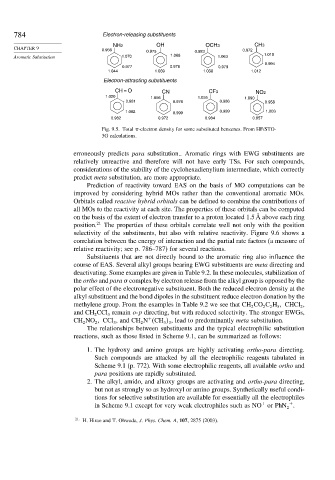Page 801 - Advanced Organic Chemistry Part A - Structure and Mechanisms, 5th ed (2007) - Carey _ Sundberg
P. 801
784 Electron-releasing substituents
NH2 OH OCH3 CH3
CHAPTER 9 0.956 0.975 0.983 0.972
Aromatic Substitution 1.070 1.068 1.063 1.018
0.994
0.977 0.976 0.979
1.044 1.039 1.038 1.012
Electron-attracting substituents
CH = O CN CF3 NO2
1.020 1.056 1.035 1.090
0.981 0.976 0.986 0.958
1.002 0.999 0.999 1.003
0.982 0.972 0.984 0.957
Fig. 9.5. Total -electron density for some substituted benzenes. From HF/STO-
3G calculations.
erroneously predicts para substitution.. Aromatic rings with EWG substituents are
relatively unreactive and therefore will not have early TSs. For such compounds,
considerations of the stability of the cyclohexadienylium intermediate, which correctly
predict meta substitution, are more appropriate.
Prediction of reactivity toward EAS on the basis of MO computations can be
improved by considering hybrid MOs rather than the conventional aromatic MOs.
Orbitals called reactive hybrid orbitals can be defined to combine the contributions of
all MOs to the reactivity at each site. The properties of these orbitals can be computed
on the basis of the extent of electron transfer to a proton located 1.5 Å above each ring
position. 21 The properties of these orbitals correlate well not only with the position
selectivity of the substituents, but also with relative reactivity. Figure 9.6 shows a
correlation between the energy of interaction and the partial rate factors (a measure of
relative reactivity; see p. 786–787) for several reactions.
Substituents that are not directly bound to the aromatic ring also influence the
course of EAS. Several alkyl groups bearing EWG substituents are meta directing and
deactivating. Some examples are given in Table 9.2. In these molecules, stabilization of
the ortho and para complex by electron release from the alkyl group is opposed by the
polar effect of the electronegative substituent. Both the reduced electron density at the
alkyl substituent and the bond dipoles in the substituent reduce electron donation by the
methylene group. From the examples in Table 9.2 we see that CH CO C H
CHCl ,
5
2
2
2
2
and CH CCl remain o-p directing, but with reduced selectivity. The stronger EWGs,
3
2
+
CH NO
CCl , and CH N CH , lead to predominantly meta substitution.
2
2
3 3
3
2
The relationships between substituents and the typical electrophilic substitution
reactions, such as those listed in Scheme 9.1, can be summarized as follows:
1. The hydroxy and amino groups are highly activating ortho-para directing.
Such compounds are attacked by all the electrophilic reagents tabulated in
Scheme 9.1 (p. 772). With some electrophilic reagents, all available ortho and
para positions are rapidly substituted.
2. The alkyl, amido, and alkoxy groups are activating and ortho-para directing,
but not as strongly so as hydroxyl or amino groups. Synthetically useful condi-
tions for selective substitution are available for essentially all the electrophiles
+
in Scheme 9.1 except for very weak electrophiles such as NO or PhN .
+
2
21
H. Hirao and T. Ohwada, J. Phys. Chem. A, 107, 2875 (2003).

